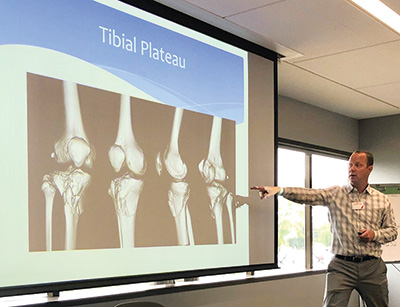Crush injuries and considerations for Workers’ Compensation

Dr. Kevin Quigley, of Signature Orthopedics St. Charles, recently presented a talk on crush injuries to the employees of Vanliner Insurance.
“Crush injuries are complex and multifaceted injuries, often affecting multiple areas of the body and various organ systems,” Quigley said. “A crush injury occurs when a part of the body is squeezed between two objects.”
Examples of crush injuries can include a leg getting caught under a large cinder block, or injuries sustained from high energy/high impact events such as semi-truck crashes.
Crush injuries are common among physical laborers and contractors, who often deal with heavy objects and are more likely to work in environments with a higher risk of physical injury.
FACTORS TO CONSIDER FOR WORKERS’ COMP.
Quigley says there are five factors that must be taken into consideration when discussing a workers’ compensation crush injury:
1. Work area factors – What are the issues within the work area environment? Is there large equipment? Are there vehicles in the vicinity?
2. Force and speed of the impact – How fast was the vehicle traveling? When the patient was hit, was it a direct impact? A side impact?
3. Size of the impact – How big was the cinder block that was preventing the leg from moving?
4. Duration of time – Complications can arise depending on how long the injury period lasts.
5. Time sequence – How long did it take to get the patient to the ER?
TYPES OF CRUSH INJURIES
While there are many ways a body can show symptoms of a crush injury, the main type of injury that orthopedic surgeons are concerned with are musculoskeletal injuries.
These include things like muscle strains, tears, ligament/tendon injuries, fractures, and joint injuries. Injuries in these parts of the body can have a significant effect on the patient’s ability to perform his or her job.
Crush injuries are particularly devastating, as they can have long-term, lasting effects, Quigley says. “These patients not only want to get back to work, they want to just get back to living life without pain or issues.”
(Kevin Quigley, MD, is an orthopedic surgeon and sports medicine physician, board-certified by the American Academy of Orthopedic Surgeons. He has extensive expertise in minimally invasive surgical techniques, fracture management, and total joint replacements of the shoulder, hip, and knee. Dr. Quigley graduated from Saint Louis University School of Medicine and completed his orthopedic surgery residency at Saint Louis University Hospital.
(Signature Medical Group’s board-certified physicians and staff are dedicated to providing workers’ compensation patients with the highest level of quality health care. Conveniently located in many locations across St. Louis and Kansas City, the Signature Medical Group Workers’ Compensation team collaborates closely with claims adjusters, nurse case managers, attorneys, and employers to help your injured employee reach their pre-injury status and safely return to work. For more information, visit signaturemedicalgroup.com.)



Leave a Reply